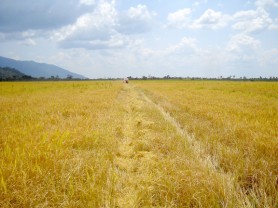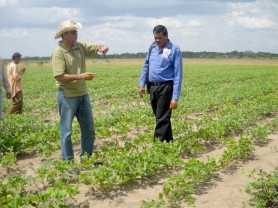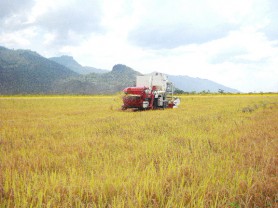A major milestone for agriculture in the Rupununi was reached as harvesting of 82 acres of paddy expected to yield between 65 to 70 tonnes of rice commenced at Moco-Moco, Region Nine on Thursday.

“This might be a little success and (show) the way to go forward,” Deputy General Manager of the Guyana Rice Development Board (GRDB) Madanlall Ramraj said of the pilot project in the flatlands bordered by the towering Kanuku Mountains. He said that success was made sweeter by the challenges faced and overcome. Ramraj, who spearheaded the Spanish-government funded project, told Stabroek News that villagers are being trained in various aspects to ensure the continuity and sustainability of the enterprise.
The venture falls under the broader Hinterland Rice and Beans Project- a food safety programme for the indigenous communities of the Rupununi Savannahs. The three-year $128M project is funded by the Spanish Agency for International Cooperation for Development in partnership with the government of Guyana, the Ministry of Agriculture and the GRDB. The project aims to develop savannah agriculture, to increase crop production and to minimise poverty in the villages. The project, which was officially launched last December by Agriculture Minister Robert Persaud, will run for three years and has among its objectives, the introduction of modern technologies to the areas where it is being implemented.
Earlier this year, at the pilot site in Moco-Moco, 82 acres of land were sown with two varieties of paddy while eleven and a half acres were sown with bean seeds. Officials described it as a success pointing out that while there were some trials before, it is the first time that rice has been grown on such a large scale in the Rupununi and such machinery is being used. The beans are not yet ready for harvesting. This crop is being planted in stages so there will be a continuous supply.

Speaking at a ceremony to commemorate the first harvest, Ramraj recalled that there were many challenges. He said that in September 2009, three acres of beans were planted but wild animals destroyed the crop and what was reaped was utilized by the community’s feeding programme. He recalled that there was a need for an irrigation network if they were to realize the goal of fully meeting the rice demands of Lethem. He said that specific areas were examined and identified and the irrigation system set up to complement rainfall. Apart from the 82 acres of paddy and the 12 acres of beans, a further 50 acres, closer to the creek, has been prepared for rice but this is still to be planted. The current bean crop is expected to yield 900 pounds per acre.
Among the other challenges experienced, Ramraj said, were they had to change staff and there was difficulty with the soil type. The soil closer to the mountains had more acidity so the yield was not the amount expected, he said. Ramraj said that they will, in the coming months, work to correct the problem by using a different fertilizer regime. “It was not insurmountable,” he concluded.

He told this newspaper that residents have been involved from the beginning and some are being trained to drive the machinery: tractor and the harvester. Currently, an operator from the coast is operating the harvester but by the next crop, a local will be operating it, he said. Villagers also helped to in sowing, applying fertilizer and building the mill and storage bond.
Quizzed on markets, Ramraj said that based on interest expressed by the business community; there would not be enough to supply them all. He said that the price may be the same as on the coast or lower and pointed out that the logistics will be easier compared to bring rice from the coast. The money from the sales will be ploughed back into the project, expanding it to other areas, and also pay those operating the machinery and involved in the project.
Ramraj said that the GRDB will continue to offer technical assistance as the villagers take over the project. Following reaping of the current crop, sowing will commence again. “At the end of it, everything is going to remain here,” he observed.
Meantime, Agriculture Minster Robert Persaud said that despite the strides made in commercialising agriculture on the coast, not much success has been made in the hinterland. He added that the government has been and will continue to pump resources to the hinterland to ensure that this transformation takes place, pointing out that the interior has certain vulnerabilities. “I am very, very optimistic that we… would be able to move to that level,” added Persaud. He said that Lethem consumes 360 tonnes of rice annually and the project can supply all of the community’s needs. Other opportunities can also flow from the venture, he said.
He pointed out that the Rupununi has the greatest potential for the commercialisation of Agriculture within the hinterland. Citing Brazil’s successful experience with savannah agriculture, Persaud said that there is a need to do soil enhancements and change agronomic practices. To get to that level, the minister pointed out that they have been working with local communities to develop capacity and they want to ensure that the project takes into account the experiences of the past, so the project can be successful. He said that the communities must ensure that there is sustainability.
Additionally, Persaud said that they have been seeking investors to utilise the vast areas for agriculture purposes. He emphasised that Amerindian lands and forests will not be compromised. He said that proposals worth over $1.5B were received. One project, Santa Fe, has already seen some $156M being spent, the Minister said. Another project by a group of Brazilian investors has been on hold because of the elections cycle in that country. Additionally, land has been allocated for a seed facility by a Brazilian company and the principality of Liechtenstein to develop seed varieties, Persaud said.
During his visit, the Minister handed over a quantity of pesticides and seeds to Moco-Moco and the surrounding villages. He also handed over a computer system and generator to the school. Minister of Amerindian Affairs Pauline Sukhai, other agricultural and regional officials were also present.
Persaud later met with Lethem business persons who raised several issues relating to agriculture, including the sourcing of vegetables from Brazil and the difficulty in getting such vegetables locally. The issue of cattle rustling was also raised. On Friday, the minister visited the Region Eight community of Kato, where he handed over a quantity of seeds, pesticides and other items.




